Masters in Healthcare Management: Clinical Leadership Report
VerifiedAdded on 2022/08/26
|12
|4205
|11
Report
AI Summary
This report critically explores the role of clinical leadership in strategic and change management within the healthcare sector. It begins with an introduction to healthcare management and the significance of clinical leadership, emphasizing its impact on patient care, safety, and job satisfaction. The report then delves into the impact of clinical leadership on strategic management, ensuring high-quality and efficient care, and on change management, highlighting the importance of ongoing communication, training, feedback mechanisms, sustained attention, and worker involvement. Approaches to clinical leadership, including transformational and participative leadership, are discussed, along with concepts and approaches to change management, such as linear models. Finally, the report outlines how healthcare professionals can influence major changes, supported by relevant literature and examples from the healthcare sector. The report underscores the evolving role of clinicians as leaders and the need for adaptability and effective change management strategies in the complex healthcare environment.

Masters in Healthcare management
Paraphrase This Document
Need a fresh take? Get an instant paraphrase of this document with our AI Paraphraser
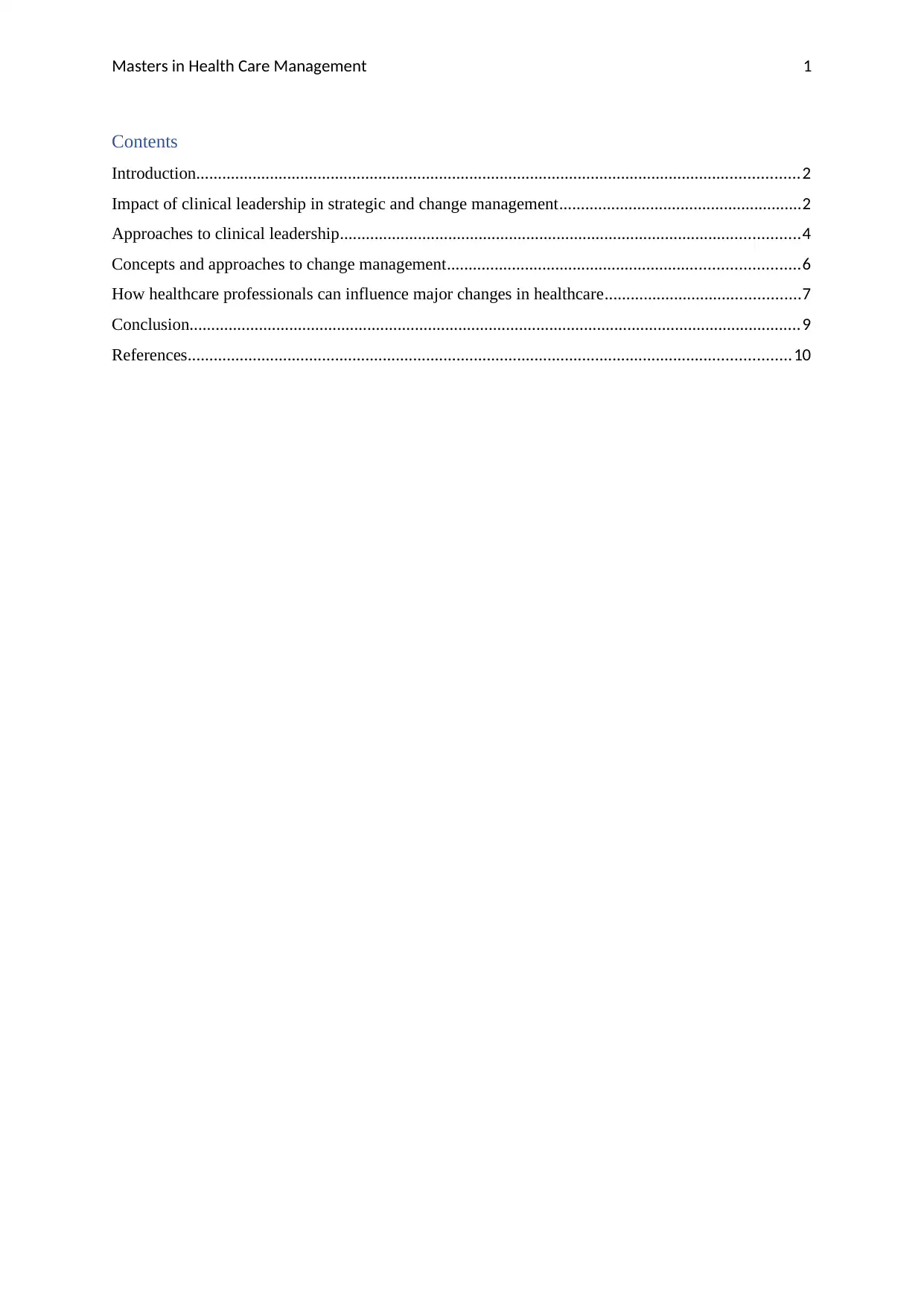
Masters in Health Care Management 1
Contents
Introduction...........................................................................................................................................2
Impact of clinical leadership in strategic and change management........................................................2
Approaches to clinical leadership..........................................................................................................4
Concepts and approaches to change management.................................................................................6
How healthcare professionals can influence major changes in healthcare.............................................7
Conclusion.............................................................................................................................................9
References...........................................................................................................................................10
Contents
Introduction...........................................................................................................................................2
Impact of clinical leadership in strategic and change management........................................................2
Approaches to clinical leadership..........................................................................................................4
Concepts and approaches to change management.................................................................................6
How healthcare professionals can influence major changes in healthcare.............................................7
Conclusion.............................................................................................................................................9
References...........................................................................................................................................10
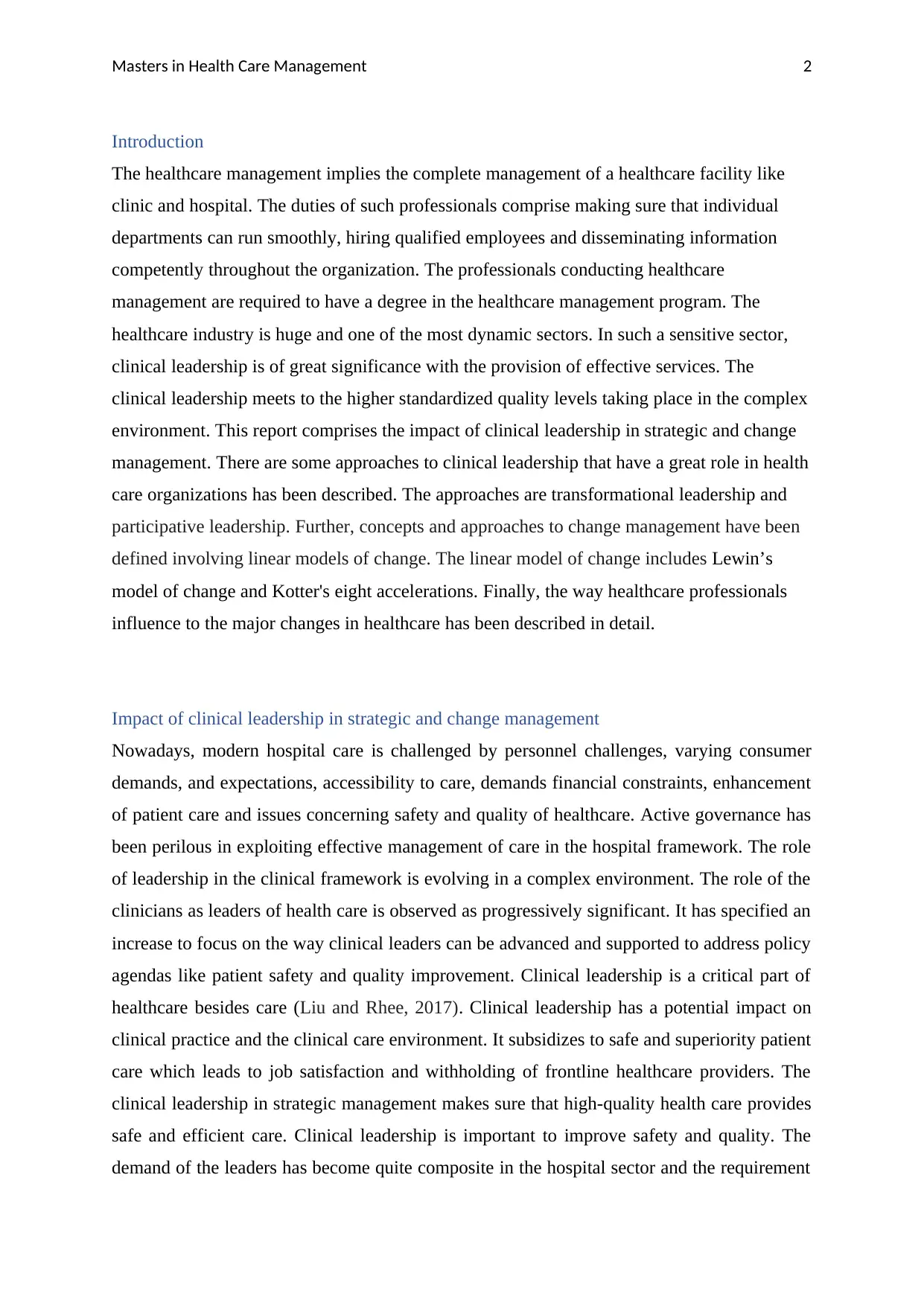
Masters in Health Care Management 2
Introduction
The healthcare management implies the complete management of a healthcare facility like
clinic and hospital. The duties of such professionals comprise making sure that individual
departments can run smoothly, hiring qualified employees and disseminating information
competently throughout the organization. The professionals conducting healthcare
management are required to have a degree in the healthcare management program. The
healthcare industry is huge and one of the most dynamic sectors. In such a sensitive sector,
clinical leadership is of great significance with the provision of effective services. The
clinical leadership meets to the higher standardized quality levels taking place in the complex
environment. This report comprises the impact of clinical leadership in strategic and change
management. There are some approaches to clinical leadership that have a great role in health
care organizations has been described. The approaches are transformational leadership and
participative leadership. Further, concepts and approaches to change management have been
defined involving linear models of change. The linear model of change includes Lewin’s
model of change and Kotter's eight accelerations. Finally, the way healthcare professionals
influence to the major changes in healthcare has been described in detail.
Impact of clinical leadership in strategic and change management
Nowadays, modern hospital care is challenged by personnel challenges, varying consumer
demands, and expectations, accessibility to care, demands financial constraints, enhancement
of patient care and issues concerning safety and quality of healthcare. Active governance has
been perilous in exploiting effective management of care in the hospital framework. The role
of leadership in the clinical framework is evolving in a complex environment. The role of the
clinicians as leaders of health care is observed as progressively significant. It has specified an
increase to focus on the way clinical leaders can be advanced and supported to address policy
agendas like patient safety and quality improvement. Clinical leadership is a critical part of
healthcare besides care (Liu and Rhee, 2017). Clinical leadership has a potential impact on
clinical practice and the clinical care environment. It subsidizes to safe and superiority patient
care which leads to job satisfaction and withholding of frontline healthcare providers. The
clinical leadership in strategic management makes sure that high-quality health care provides
safe and efficient care. Clinical leadership is important to improve safety and quality. The
demand of the leaders has become quite composite in the hospital sector and the requirement
Introduction
The healthcare management implies the complete management of a healthcare facility like
clinic and hospital. The duties of such professionals comprise making sure that individual
departments can run smoothly, hiring qualified employees and disseminating information
competently throughout the organization. The professionals conducting healthcare
management are required to have a degree in the healthcare management program. The
healthcare industry is huge and one of the most dynamic sectors. In such a sensitive sector,
clinical leadership is of great significance with the provision of effective services. The
clinical leadership meets to the higher standardized quality levels taking place in the complex
environment. This report comprises the impact of clinical leadership in strategic and change
management. There are some approaches to clinical leadership that have a great role in health
care organizations has been described. The approaches are transformational leadership and
participative leadership. Further, concepts and approaches to change management have been
defined involving linear models of change. The linear model of change includes Lewin’s
model of change and Kotter's eight accelerations. Finally, the way healthcare professionals
influence to the major changes in healthcare has been described in detail.
Impact of clinical leadership in strategic and change management
Nowadays, modern hospital care is challenged by personnel challenges, varying consumer
demands, and expectations, accessibility to care, demands financial constraints, enhancement
of patient care and issues concerning safety and quality of healthcare. Active governance has
been perilous in exploiting effective management of care in the hospital framework. The role
of leadership in the clinical framework is evolving in a complex environment. The role of the
clinicians as leaders of health care is observed as progressively significant. It has specified an
increase to focus on the way clinical leaders can be advanced and supported to address policy
agendas like patient safety and quality improvement. Clinical leadership is a critical part of
healthcare besides care (Liu and Rhee, 2017). Clinical leadership has a potential impact on
clinical practice and the clinical care environment. It subsidizes to safe and superiority patient
care which leads to job satisfaction and withholding of frontline healthcare providers. The
clinical leadership in strategic management makes sure that high-quality health care provides
safe and efficient care. Clinical leadership is important to improve safety and quality. The
demand of the leaders has become quite composite in the hospital sector and the requirement
⊘ This is a preview!⊘
Do you want full access?
Subscribe today to unlock all pages.

Trusted by 1+ million students worldwide
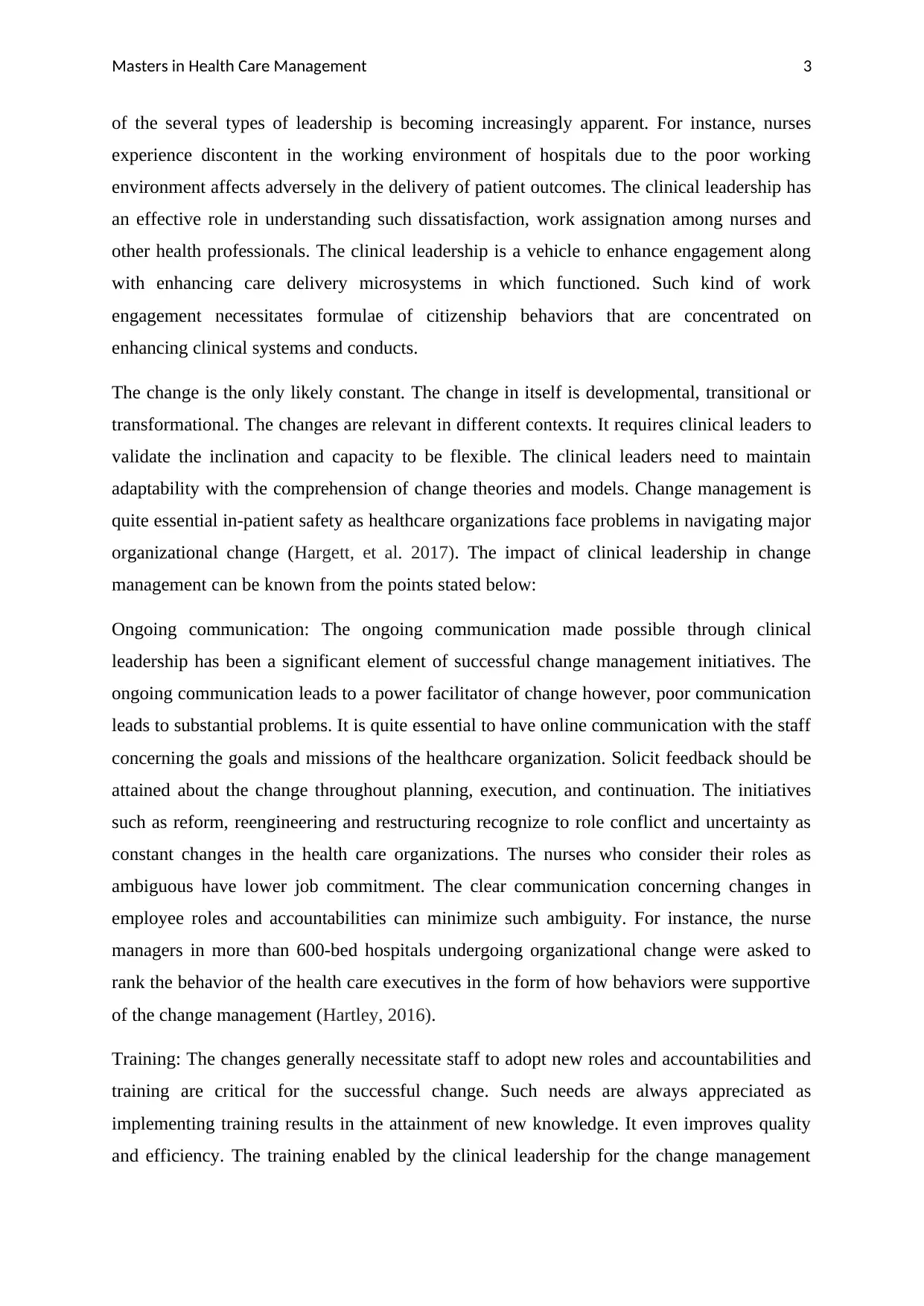
Masters in Health Care Management 3
of the several types of leadership is becoming increasingly apparent. For instance, nurses
experience discontent in the working environment of hospitals due to the poor working
environment affects adversely in the delivery of patient outcomes. The clinical leadership has
an effective role in understanding such dissatisfaction, work assignation among nurses and
other health professionals. The clinical leadership is a vehicle to enhance engagement along
with enhancing care delivery microsystems in which functioned. Such kind of work
engagement necessitates formulae of citizenship behaviors that are concentrated on
enhancing clinical systems and conducts.
The change is the only likely constant. The change in itself is developmental, transitional or
transformational. The changes are relevant in different contexts. It requires clinical leaders to
validate the inclination and capacity to be flexible. The clinical leaders need to maintain
adaptability with the comprehension of change theories and models. Change management is
quite essential in-patient safety as healthcare organizations face problems in navigating major
organizational change (Hargett, et al. 2017). The impact of clinical leadership in change
management can be known from the points stated below:
Ongoing communication: The ongoing communication made possible through clinical
leadership has been a significant element of successful change management initiatives. The
ongoing communication leads to a power facilitator of change however, poor communication
leads to substantial problems. It is quite essential to have online communication with the staff
concerning the goals and missions of the healthcare organization. Solicit feedback should be
attained about the change throughout planning, execution, and continuation. The initiatives
such as reform, reengineering and restructuring recognize to role conflict and uncertainty as
constant changes in the health care organizations. The nurses who consider their roles as
ambiguous have lower job commitment. The clear communication concerning changes in
employee roles and accountabilities can minimize such ambiguity. For instance, the nurse
managers in more than 600-bed hospitals undergoing organizational change were asked to
rank the behavior of the health care executives in the form of how behaviors were supportive
of the change management (Hartley, 2016).
Training: The changes generally necessitate staff to adopt new roles and accountabilities and
training are critical for the successful change. Such needs are always appreciated as
implementing training results in the attainment of new knowledge. It even improves quality
and efficiency. The training enabled by the clinical leadership for the change management
of the several types of leadership is becoming increasingly apparent. For instance, nurses
experience discontent in the working environment of hospitals due to the poor working
environment affects adversely in the delivery of patient outcomes. The clinical leadership has
an effective role in understanding such dissatisfaction, work assignation among nurses and
other health professionals. The clinical leadership is a vehicle to enhance engagement along
with enhancing care delivery microsystems in which functioned. Such kind of work
engagement necessitates formulae of citizenship behaviors that are concentrated on
enhancing clinical systems and conducts.
The change is the only likely constant. The change in itself is developmental, transitional or
transformational. The changes are relevant in different contexts. It requires clinical leaders to
validate the inclination and capacity to be flexible. The clinical leaders need to maintain
adaptability with the comprehension of change theories and models. Change management is
quite essential in-patient safety as healthcare organizations face problems in navigating major
organizational change (Hargett, et al. 2017). The impact of clinical leadership in change
management can be known from the points stated below:
Ongoing communication: The ongoing communication made possible through clinical
leadership has been a significant element of successful change management initiatives. The
ongoing communication leads to a power facilitator of change however, poor communication
leads to substantial problems. It is quite essential to have online communication with the staff
concerning the goals and missions of the healthcare organization. Solicit feedback should be
attained about the change throughout planning, execution, and continuation. The initiatives
such as reform, reengineering and restructuring recognize to role conflict and uncertainty as
constant changes in the health care organizations. The nurses who consider their roles as
ambiguous have lower job commitment. The clear communication concerning changes in
employee roles and accountabilities can minimize such ambiguity. For instance, the nurse
managers in more than 600-bed hospitals undergoing organizational change were asked to
rank the behavior of the health care executives in the form of how behaviors were supportive
of the change management (Hartley, 2016).
Training: The changes generally necessitate staff to adopt new roles and accountabilities and
training are critical for the successful change. Such needs are always appreciated as
implementing training results in the attainment of new knowledge. It even improves quality
and efficiency. The training enabled by the clinical leadership for the change management
Paraphrase This Document
Need a fresh take? Get an instant paraphrase of this document with our AI Paraphraser
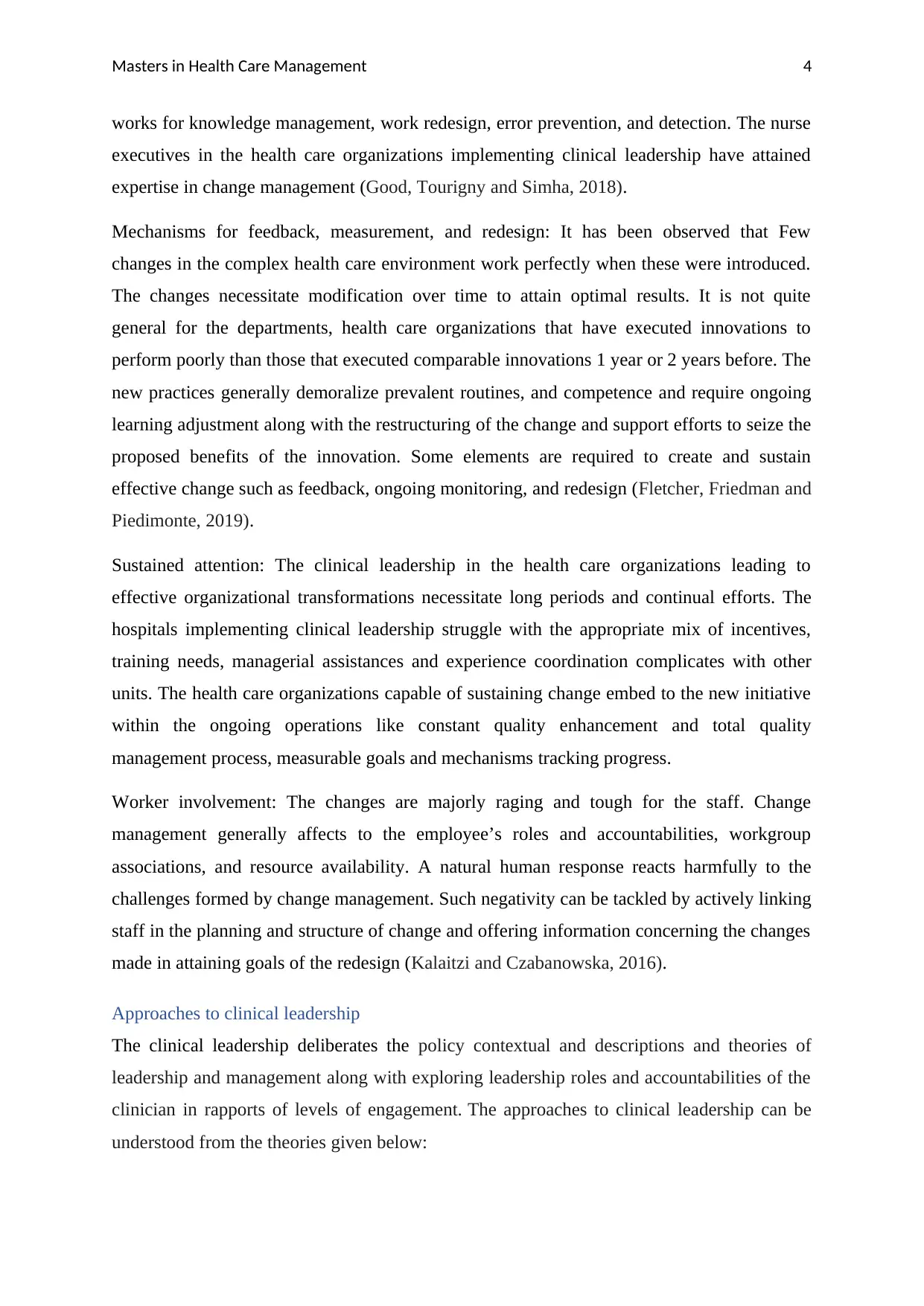
Masters in Health Care Management 4
works for knowledge management, work redesign, error prevention, and detection. The nurse
executives in the health care organizations implementing clinical leadership have attained
expertise in change management (Good, Tourigny and Simha, 2018).
Mechanisms for feedback, measurement, and redesign: It has been observed that Few
changes in the complex health care environment work perfectly when these were introduced.
The changes necessitate modification over time to attain optimal results. It is not quite
general for the departments, health care organizations that have executed innovations to
perform poorly than those that executed comparable innovations 1 year or 2 years before. The
new practices generally demoralize prevalent routines, and competence and require ongoing
learning adjustment along with the restructuring of the change and support efforts to seize the
proposed benefits of the innovation. Some elements are required to create and sustain
effective change such as feedback, ongoing monitoring, and redesign (Fletcher, Friedman and
Piedimonte, 2019).
Sustained attention: The clinical leadership in the health care organizations leading to
effective organizational transformations necessitate long periods and continual efforts. The
hospitals implementing clinical leadership struggle with the appropriate mix of incentives,
training needs, managerial assistances and experience coordination complicates with other
units. The health care organizations capable of sustaining change embed to the new initiative
within the ongoing operations like constant quality enhancement and total quality
management process, measurable goals and mechanisms tracking progress.
Worker involvement: The changes are majorly raging and tough for the staff. Change
management generally affects to the employee’s roles and accountabilities, workgroup
associations, and resource availability. A natural human response reacts harmfully to the
challenges formed by change management. Such negativity can be tackled by actively linking
staff in the planning and structure of change and offering information concerning the changes
made in attaining goals of the redesign (Kalaitzi and Czabanowska, 2016).
Approaches to clinical leadership
The clinical leadership deliberates the policy contextual and descriptions and theories of
leadership and management along with exploring leadership roles and accountabilities of the
clinician in rapports of levels of engagement. The approaches to clinical leadership can be
understood from the theories given below:
works for knowledge management, work redesign, error prevention, and detection. The nurse
executives in the health care organizations implementing clinical leadership have attained
expertise in change management (Good, Tourigny and Simha, 2018).
Mechanisms for feedback, measurement, and redesign: It has been observed that Few
changes in the complex health care environment work perfectly when these were introduced.
The changes necessitate modification over time to attain optimal results. It is not quite
general for the departments, health care organizations that have executed innovations to
perform poorly than those that executed comparable innovations 1 year or 2 years before. The
new practices generally demoralize prevalent routines, and competence and require ongoing
learning adjustment along with the restructuring of the change and support efforts to seize the
proposed benefits of the innovation. Some elements are required to create and sustain
effective change such as feedback, ongoing monitoring, and redesign (Fletcher, Friedman and
Piedimonte, 2019).
Sustained attention: The clinical leadership in the health care organizations leading to
effective organizational transformations necessitate long periods and continual efforts. The
hospitals implementing clinical leadership struggle with the appropriate mix of incentives,
training needs, managerial assistances and experience coordination complicates with other
units. The health care organizations capable of sustaining change embed to the new initiative
within the ongoing operations like constant quality enhancement and total quality
management process, measurable goals and mechanisms tracking progress.
Worker involvement: The changes are majorly raging and tough for the staff. Change
management generally affects to the employee’s roles and accountabilities, workgroup
associations, and resource availability. A natural human response reacts harmfully to the
challenges formed by change management. Such negativity can be tackled by actively linking
staff in the planning and structure of change and offering information concerning the changes
made in attaining goals of the redesign (Kalaitzi and Czabanowska, 2016).
Approaches to clinical leadership
The clinical leadership deliberates the policy contextual and descriptions and theories of
leadership and management along with exploring leadership roles and accountabilities of the
clinician in rapports of levels of engagement. The approaches to clinical leadership can be
understood from the theories given below:
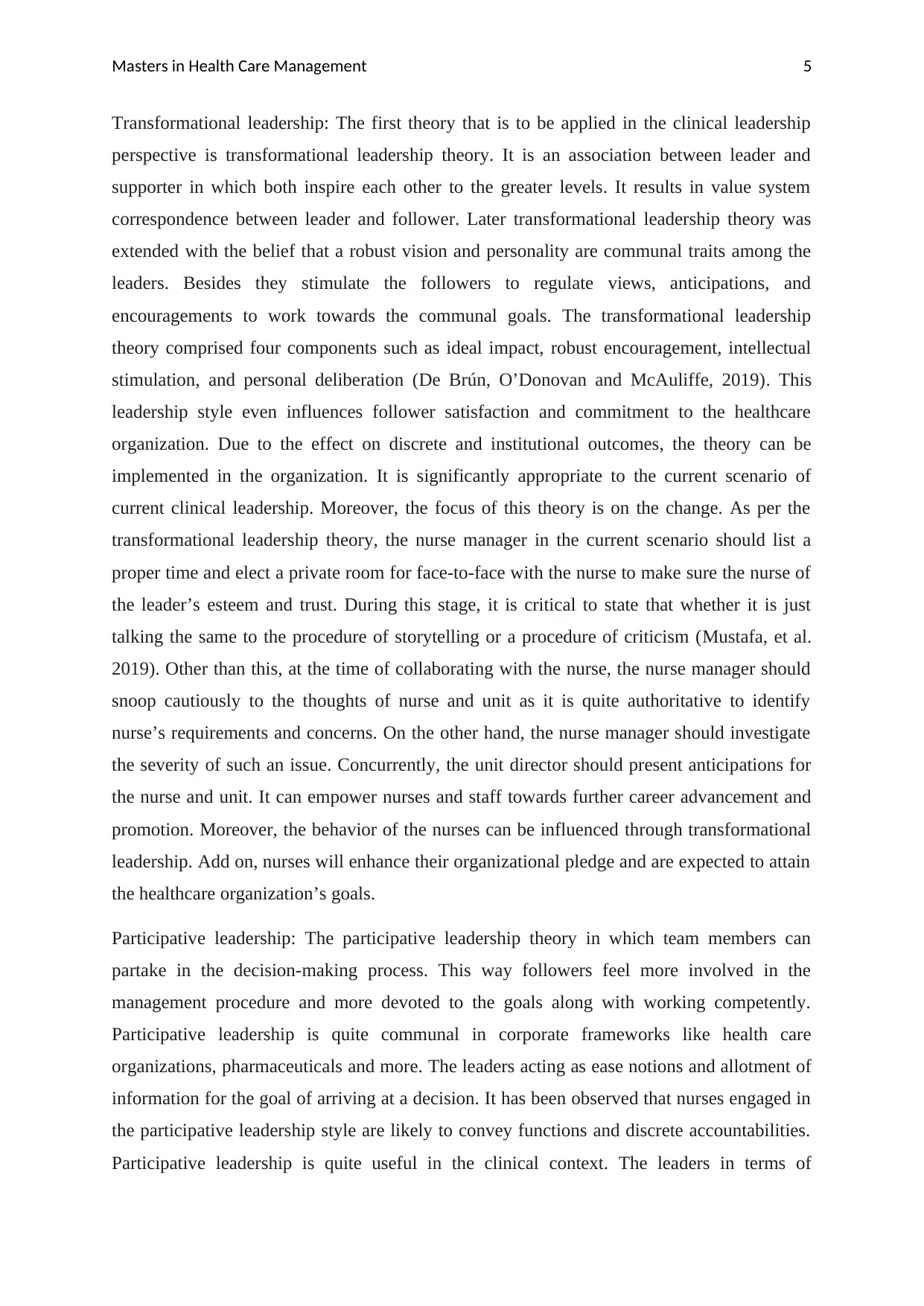
Masters in Health Care Management 5
Transformational leadership: The first theory that is to be applied in the clinical leadership
perspective is transformational leadership theory. It is an association between leader and
supporter in which both inspire each other to the greater levels. It results in value system
correspondence between leader and follower. Later transformational leadership theory was
extended with the belief that a robust vision and personality are communal traits among the
leaders. Besides they stimulate the followers to regulate views, anticipations, and
encouragements to work towards the communal goals. The transformational leadership
theory comprised four components such as ideal impact, robust encouragement, intellectual
stimulation, and personal deliberation (De Brún, O’Donovan and McAuliffe, 2019). This
leadership style even influences follower satisfaction and commitment to the healthcare
organization. Due to the effect on discrete and institutional outcomes, the theory can be
implemented in the organization. It is significantly appropriate to the current scenario of
current clinical leadership. Moreover, the focus of this theory is on the change. As per the
transformational leadership theory, the nurse manager in the current scenario should list a
proper time and elect a private room for face-to-face with the nurse to make sure the nurse of
the leader’s esteem and trust. During this stage, it is critical to state that whether it is just
talking the same to the procedure of storytelling or a procedure of criticism (Mustafa, et al.
2019). Other than this, at the time of collaborating with the nurse, the nurse manager should
snoop cautiously to the thoughts of nurse and unit as it is quite authoritative to identify
nurse’s requirements and concerns. On the other hand, the nurse manager should investigate
the severity of such an issue. Concurrently, the unit director should present anticipations for
the nurse and unit. It can empower nurses and staff towards further career advancement and
promotion. Moreover, the behavior of the nurses can be influenced through transformational
leadership. Add on, nurses will enhance their organizational pledge and are expected to attain
the healthcare organization’s goals.
Participative leadership: The participative leadership theory in which team members can
partake in the decision-making process. This way followers feel more involved in the
management procedure and more devoted to the goals along with working competently.
Participative leadership is quite communal in corporate frameworks like health care
organizations, pharmaceuticals and more. The leaders acting as ease notions and allotment of
information for the goal of arriving at a decision. It has been observed that nurses engaged in
the participative leadership style are likely to convey functions and discrete accountabilities.
Participative leadership is quite useful in the clinical context. The leaders in terms of
Transformational leadership: The first theory that is to be applied in the clinical leadership
perspective is transformational leadership theory. It is an association between leader and
supporter in which both inspire each other to the greater levels. It results in value system
correspondence between leader and follower. Later transformational leadership theory was
extended with the belief that a robust vision and personality are communal traits among the
leaders. Besides they stimulate the followers to regulate views, anticipations, and
encouragements to work towards the communal goals. The transformational leadership
theory comprised four components such as ideal impact, robust encouragement, intellectual
stimulation, and personal deliberation (De Brún, O’Donovan and McAuliffe, 2019). This
leadership style even influences follower satisfaction and commitment to the healthcare
organization. Due to the effect on discrete and institutional outcomes, the theory can be
implemented in the organization. It is significantly appropriate to the current scenario of
current clinical leadership. Moreover, the focus of this theory is on the change. As per the
transformational leadership theory, the nurse manager in the current scenario should list a
proper time and elect a private room for face-to-face with the nurse to make sure the nurse of
the leader’s esteem and trust. During this stage, it is critical to state that whether it is just
talking the same to the procedure of storytelling or a procedure of criticism (Mustafa, et al.
2019). Other than this, at the time of collaborating with the nurse, the nurse manager should
snoop cautiously to the thoughts of nurse and unit as it is quite authoritative to identify
nurse’s requirements and concerns. On the other hand, the nurse manager should investigate
the severity of such an issue. Concurrently, the unit director should present anticipations for
the nurse and unit. It can empower nurses and staff towards further career advancement and
promotion. Moreover, the behavior of the nurses can be influenced through transformational
leadership. Add on, nurses will enhance their organizational pledge and are expected to attain
the healthcare organization’s goals.
Participative leadership: The participative leadership theory in which team members can
partake in the decision-making process. This way followers feel more involved in the
management procedure and more devoted to the goals along with working competently.
Participative leadership is quite communal in corporate frameworks like health care
organizations, pharmaceuticals and more. The leaders acting as ease notions and allotment of
information for the goal of arriving at a decision. It has been observed that nurses engaged in
the participative leadership style are likely to convey functions and discrete accountabilities.
Participative leadership is quite useful in the clinical context. The leaders in terms of
⊘ This is a preview!⊘
Do you want full access?
Subscribe today to unlock all pages.

Trusted by 1+ million students worldwide
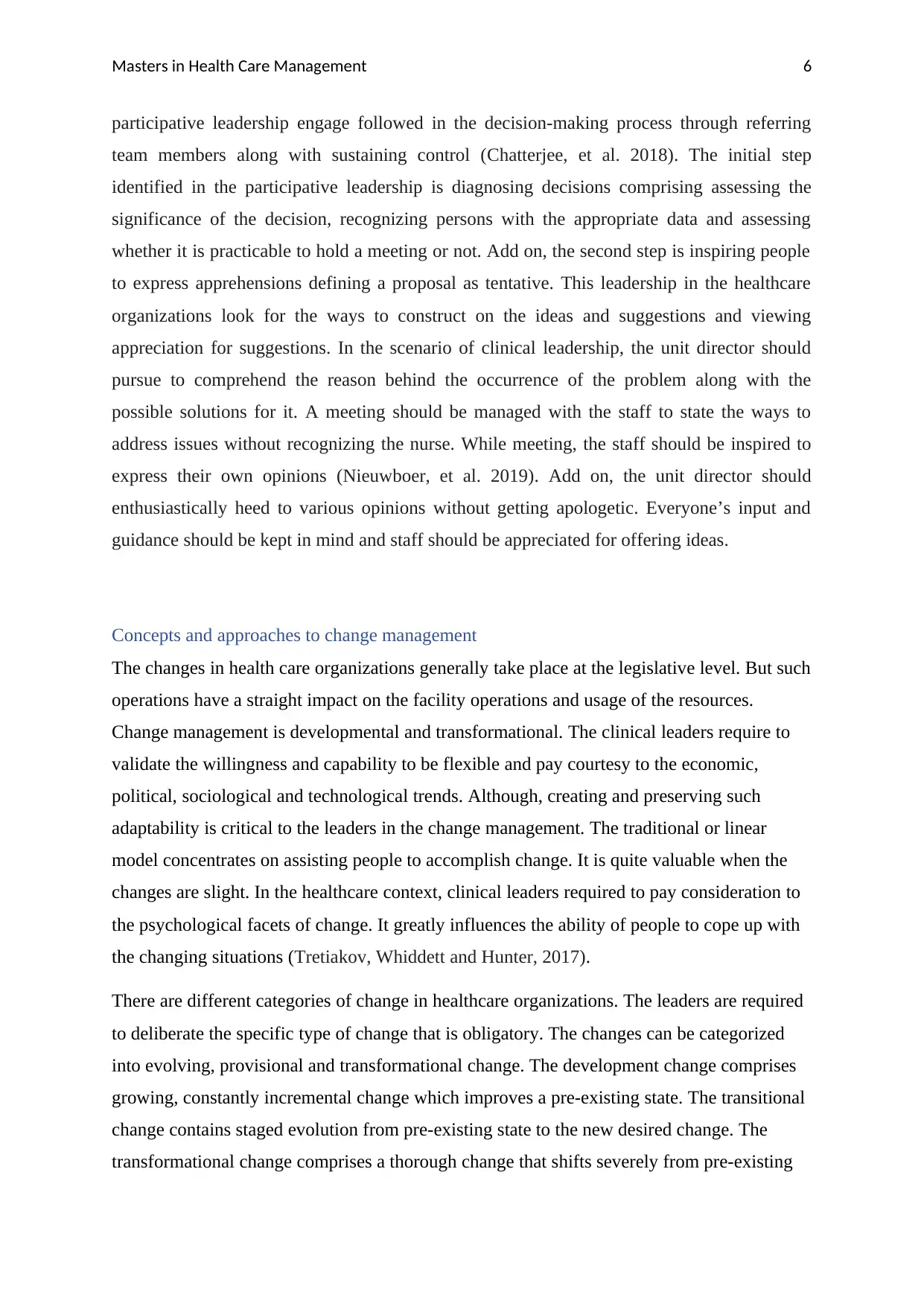
Masters in Health Care Management 6
participative leadership engage followed in the decision-making process through referring
team members along with sustaining control (Chatterjee, et al. 2018). The initial step
identified in the participative leadership is diagnosing decisions comprising assessing the
significance of the decision, recognizing persons with the appropriate data and assessing
whether it is practicable to hold a meeting or not. Add on, the second step is inspiring people
to express apprehensions defining a proposal as tentative. This leadership in the healthcare
organizations look for the ways to construct on the ideas and suggestions and viewing
appreciation for suggestions. In the scenario of clinical leadership, the unit director should
pursue to comprehend the reason behind the occurrence of the problem along with the
possible solutions for it. A meeting should be managed with the staff to state the ways to
address issues without recognizing the nurse. While meeting, the staff should be inspired to
express their own opinions (Nieuwboer, et al. 2019). Add on, the unit director should
enthusiastically heed to various opinions without getting apologetic. Everyone’s input and
guidance should be kept in mind and staff should be appreciated for offering ideas.
Concepts and approaches to change management
The changes in health care organizations generally take place at the legislative level. But such
operations have a straight impact on the facility operations and usage of the resources.
Change management is developmental and transformational. The clinical leaders require to
validate the willingness and capability to be flexible and pay courtesy to the economic,
political, sociological and technological trends. Although, creating and preserving such
adaptability is critical to the leaders in the change management. The traditional or linear
model concentrates on assisting people to accomplish change. It is quite valuable when the
changes are slight. In the healthcare context, clinical leaders required to pay consideration to
the psychological facets of change. It greatly influences the ability of people to cope up with
the changing situations (Tretiakov, Whiddett and Hunter, 2017).
There are different categories of change in healthcare organizations. The leaders are required
to deliberate the specific type of change that is obligatory. The changes can be categorized
into evolving, provisional and transformational change. The development change comprises
growing, constantly incremental change which improves a pre-existing state. The transitional
change contains staged evolution from pre-existing state to the new desired change. The
transformational change comprises a thorough change that shifts severely from pre-existing
participative leadership engage followed in the decision-making process through referring
team members along with sustaining control (Chatterjee, et al. 2018). The initial step
identified in the participative leadership is diagnosing decisions comprising assessing the
significance of the decision, recognizing persons with the appropriate data and assessing
whether it is practicable to hold a meeting or not. Add on, the second step is inspiring people
to express apprehensions defining a proposal as tentative. This leadership in the healthcare
organizations look for the ways to construct on the ideas and suggestions and viewing
appreciation for suggestions. In the scenario of clinical leadership, the unit director should
pursue to comprehend the reason behind the occurrence of the problem along with the
possible solutions for it. A meeting should be managed with the staff to state the ways to
address issues without recognizing the nurse. While meeting, the staff should be inspired to
express their own opinions (Nieuwboer, et al. 2019). Add on, the unit director should
enthusiastically heed to various opinions without getting apologetic. Everyone’s input and
guidance should be kept in mind and staff should be appreciated for offering ideas.
Concepts and approaches to change management
The changes in health care organizations generally take place at the legislative level. But such
operations have a straight impact on the facility operations and usage of the resources.
Change management is developmental and transformational. The clinical leaders require to
validate the willingness and capability to be flexible and pay courtesy to the economic,
political, sociological and technological trends. Although, creating and preserving such
adaptability is critical to the leaders in the change management. The traditional or linear
model concentrates on assisting people to accomplish change. It is quite valuable when the
changes are slight. In the healthcare context, clinical leaders required to pay consideration to
the psychological facets of change. It greatly influences the ability of people to cope up with
the changing situations (Tretiakov, Whiddett and Hunter, 2017).
There are different categories of change in healthcare organizations. The leaders are required
to deliberate the specific type of change that is obligatory. The changes can be categorized
into evolving, provisional and transformational change. The development change comprises
growing, constantly incremental change which improves a pre-existing state. The transitional
change contains staged evolution from pre-existing state to the new desired change. The
transformational change comprises a thorough change that shifts severely from pre-existing
Paraphrase This Document
Need a fresh take? Get an instant paraphrase of this document with our AI Paraphraser
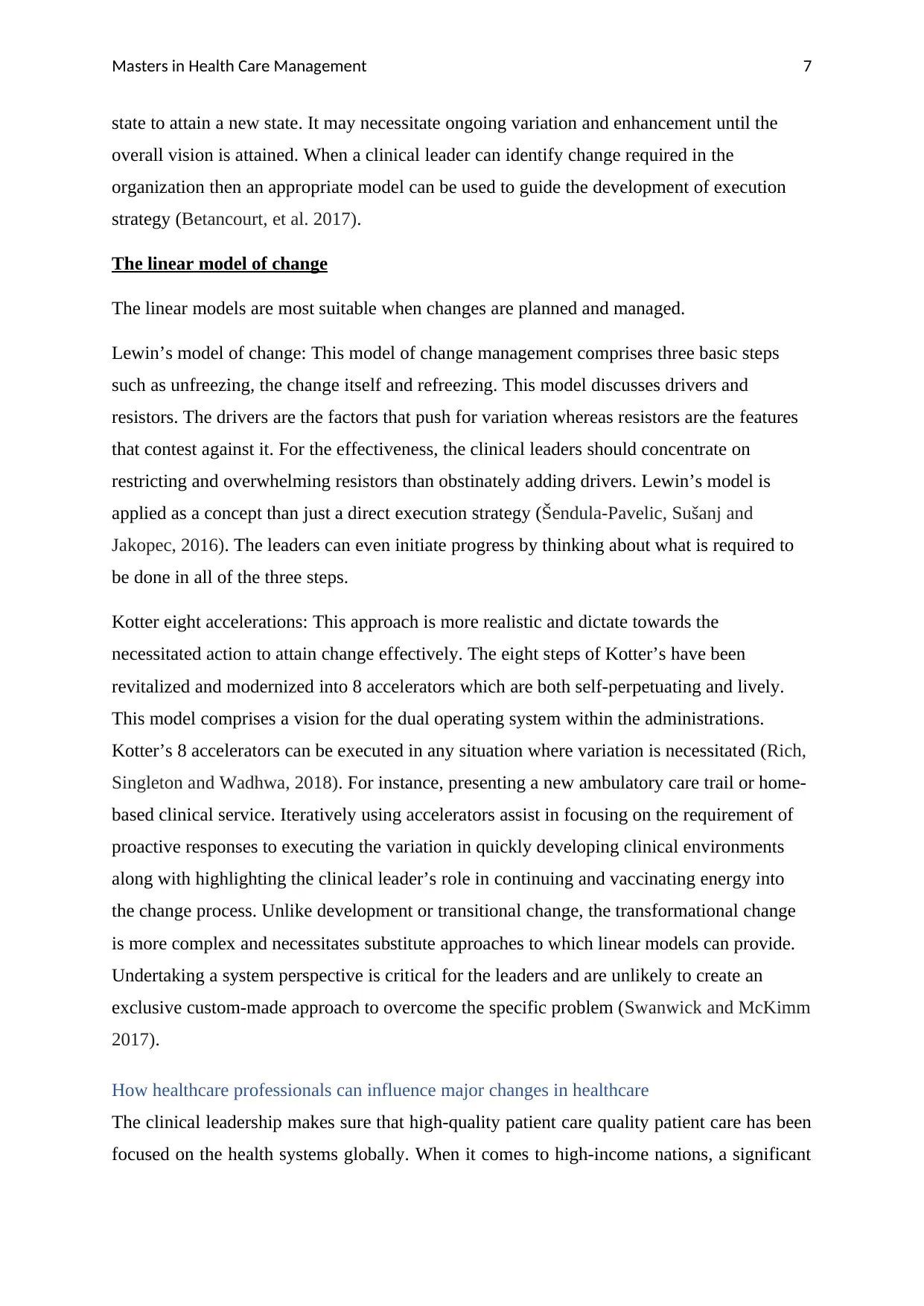
Masters in Health Care Management 7
state to attain a new state. It may necessitate ongoing variation and enhancement until the
overall vision is attained. When a clinical leader can identify change required in the
organization then an appropriate model can be used to guide the development of execution
strategy (Betancourt, et al. 2017).
The linear model of change
The linear models are most suitable when changes are planned and managed.
Lewin’s model of change: This model of change management comprises three basic steps
such as unfreezing, the change itself and refreezing. This model discusses drivers and
resistors. The drivers are the factors that push for variation whereas resistors are the features
that contest against it. For the effectiveness, the clinical leaders should concentrate on
restricting and overwhelming resistors than obstinately adding drivers. Lewin’s model is
applied as a concept than just a direct execution strategy (Šendula-Pavelic, Sušanj and
Jakopec, 2016). The leaders can even initiate progress by thinking about what is required to
be done in all of the three steps.
Kotter eight accelerations: This approach is more realistic and dictate towards the
necessitated action to attain change effectively. The eight steps of Kotter’s have been
revitalized and modernized into 8 accelerators which are both self-perpetuating and lively.
This model comprises a vision for the dual operating system within the administrations.
Kotter’s 8 accelerators can be executed in any situation where variation is necessitated (Rich,
Singleton and Wadhwa, 2018). For instance, presenting a new ambulatory care trail or home-
based clinical service. Iteratively using accelerators assist in focusing on the requirement of
proactive responses to executing the variation in quickly developing clinical environments
along with highlighting the clinical leader’s role in continuing and vaccinating energy into
the change process. Unlike development or transitional change, the transformational change
is more complex and necessitates substitute approaches to which linear models can provide.
Undertaking a system perspective is critical for the leaders and are unlikely to create an
exclusive custom-made approach to overcome the specific problem (Swanwick and McKimm
2017).
How healthcare professionals can influence major changes in healthcare
The clinical leadership makes sure that high-quality patient care quality patient care has been
focused on the health systems globally. When it comes to high-income nations, a significant
state to attain a new state. It may necessitate ongoing variation and enhancement until the
overall vision is attained. When a clinical leader can identify change required in the
organization then an appropriate model can be used to guide the development of execution
strategy (Betancourt, et al. 2017).
The linear model of change
The linear models are most suitable when changes are planned and managed.
Lewin’s model of change: This model of change management comprises three basic steps
such as unfreezing, the change itself and refreezing. This model discusses drivers and
resistors. The drivers are the factors that push for variation whereas resistors are the features
that contest against it. For the effectiveness, the clinical leaders should concentrate on
restricting and overwhelming resistors than obstinately adding drivers. Lewin’s model is
applied as a concept than just a direct execution strategy (Šendula-Pavelic, Sušanj and
Jakopec, 2016). The leaders can even initiate progress by thinking about what is required to
be done in all of the three steps.
Kotter eight accelerations: This approach is more realistic and dictate towards the
necessitated action to attain change effectively. The eight steps of Kotter’s have been
revitalized and modernized into 8 accelerators which are both self-perpetuating and lively.
This model comprises a vision for the dual operating system within the administrations.
Kotter’s 8 accelerators can be executed in any situation where variation is necessitated (Rich,
Singleton and Wadhwa, 2018). For instance, presenting a new ambulatory care trail or home-
based clinical service. Iteratively using accelerators assist in focusing on the requirement of
proactive responses to executing the variation in quickly developing clinical environments
along with highlighting the clinical leader’s role in continuing and vaccinating energy into
the change process. Unlike development or transitional change, the transformational change
is more complex and necessitates substitute approaches to which linear models can provide.
Undertaking a system perspective is critical for the leaders and are unlikely to create an
exclusive custom-made approach to overcome the specific problem (Swanwick and McKimm
2017).
How healthcare professionals can influence major changes in healthcare
The clinical leadership makes sure that high-quality patient care quality patient care has been
focused on the health systems globally. When it comes to high-income nations, a significant
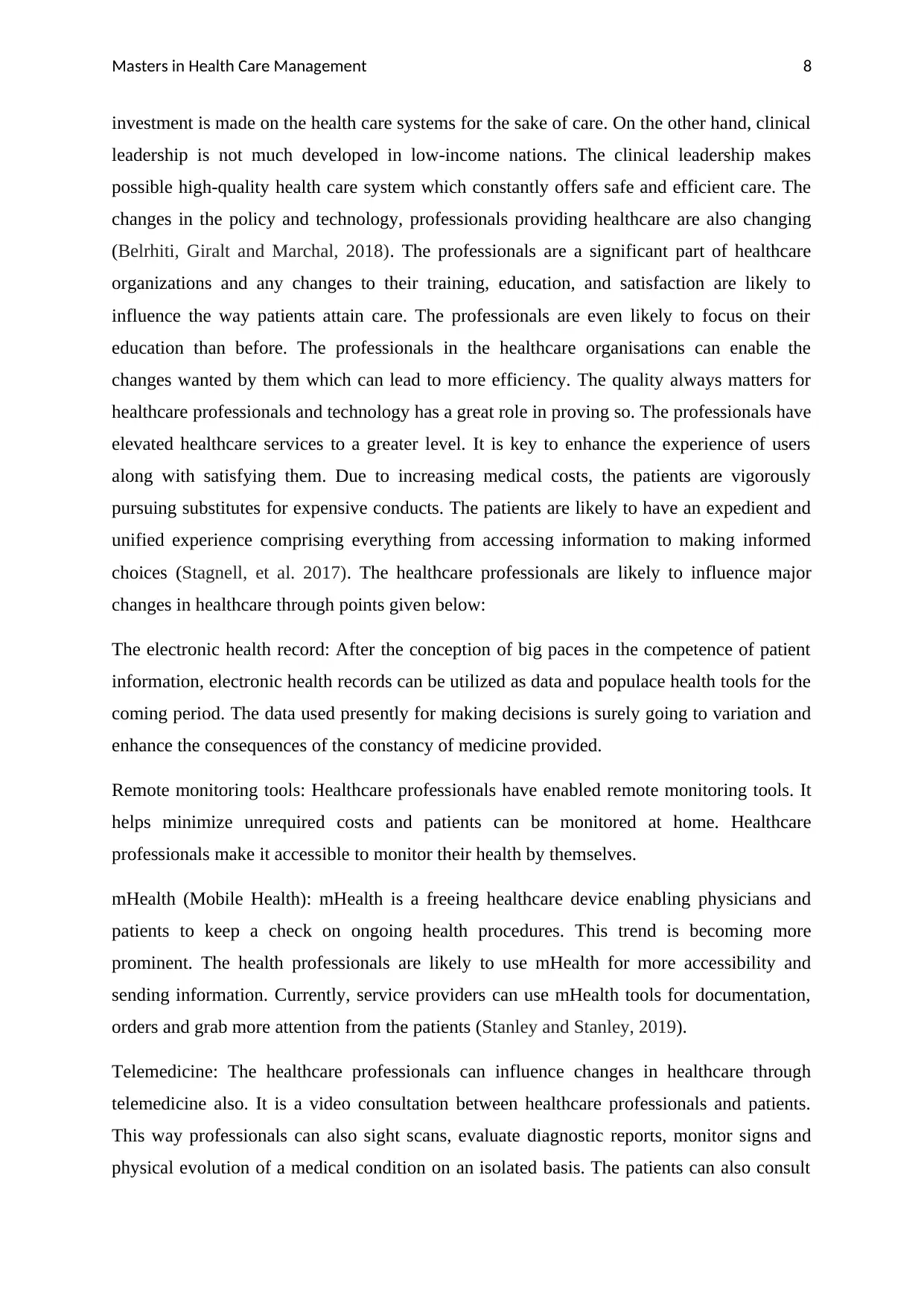
Masters in Health Care Management 8
investment is made on the health care systems for the sake of care. On the other hand, clinical
leadership is not much developed in low-income nations. The clinical leadership makes
possible high-quality health care system which constantly offers safe and efficient care. The
changes in the policy and technology, professionals providing healthcare are also changing
(Belrhiti, Giralt and Marchal, 2018). The professionals are a significant part of healthcare
organizations and any changes to their training, education, and satisfaction are likely to
influence the way patients attain care. The professionals are even likely to focus on their
education than before. The professionals in the healthcare organisations can enable the
changes wanted by them which can lead to more efficiency. The quality always matters for
healthcare professionals and technology has a great role in proving so. The professionals have
elevated healthcare services to a greater level. It is key to enhance the experience of users
along with satisfying them. Due to increasing medical costs, the patients are vigorously
pursuing substitutes for expensive conducts. The patients are likely to have an expedient and
unified experience comprising everything from accessing information to making informed
choices (Stagnell, et al. 2017). The healthcare professionals are likely to influence major
changes in healthcare through points given below:
The electronic health record: After the conception of big paces in the competence of patient
information, electronic health records can be utilized as data and populace health tools for the
coming period. The data used presently for making decisions is surely going to variation and
enhance the consequences of the constancy of medicine provided.
Remote monitoring tools: Healthcare professionals have enabled remote monitoring tools. It
helps minimize unrequired costs and patients can be monitored at home. Healthcare
professionals make it accessible to monitor their health by themselves.
mHealth (Mobile Health): mHealth is a freeing healthcare device enabling physicians and
patients to keep a check on ongoing health procedures. This trend is becoming more
prominent. The health professionals are likely to use mHealth for more accessibility and
sending information. Currently, service providers can use mHealth tools for documentation,
orders and grab more attention from the patients (Stanley and Stanley, 2019).
Telemedicine: The healthcare professionals can influence changes in healthcare through
telemedicine also. It is a video consultation between healthcare professionals and patients.
This way professionals can also sight scans, evaluate diagnostic reports, monitor signs and
physical evolution of a medical condition on an isolated basis. The patients can also consult
investment is made on the health care systems for the sake of care. On the other hand, clinical
leadership is not much developed in low-income nations. The clinical leadership makes
possible high-quality health care system which constantly offers safe and efficient care. The
changes in the policy and technology, professionals providing healthcare are also changing
(Belrhiti, Giralt and Marchal, 2018). The professionals are a significant part of healthcare
organizations and any changes to their training, education, and satisfaction are likely to
influence the way patients attain care. The professionals are even likely to focus on their
education than before. The professionals in the healthcare organisations can enable the
changes wanted by them which can lead to more efficiency. The quality always matters for
healthcare professionals and technology has a great role in proving so. The professionals have
elevated healthcare services to a greater level. It is key to enhance the experience of users
along with satisfying them. Due to increasing medical costs, the patients are vigorously
pursuing substitutes for expensive conducts. The patients are likely to have an expedient and
unified experience comprising everything from accessing information to making informed
choices (Stagnell, et al. 2017). The healthcare professionals are likely to influence major
changes in healthcare through points given below:
The electronic health record: After the conception of big paces in the competence of patient
information, electronic health records can be utilized as data and populace health tools for the
coming period. The data used presently for making decisions is surely going to variation and
enhance the consequences of the constancy of medicine provided.
Remote monitoring tools: Healthcare professionals have enabled remote monitoring tools. It
helps minimize unrequired costs and patients can be monitored at home. Healthcare
professionals make it accessible to monitor their health by themselves.
mHealth (Mobile Health): mHealth is a freeing healthcare device enabling physicians and
patients to keep a check on ongoing health procedures. This trend is becoming more
prominent. The health professionals are likely to use mHealth for more accessibility and
sending information. Currently, service providers can use mHealth tools for documentation,
orders and grab more attention from the patients (Stanley and Stanley, 2019).
Telemedicine: The healthcare professionals can influence changes in healthcare through
telemedicine also. It is a video consultation between healthcare professionals and patients.
This way professionals can also sight scans, evaluate diagnostic reports, monitor signs and
physical evolution of a medical condition on an isolated basis. The patients can also consult
⊘ This is a preview!⊘
Do you want full access?
Subscribe today to unlock all pages.

Trusted by 1+ million students worldwide
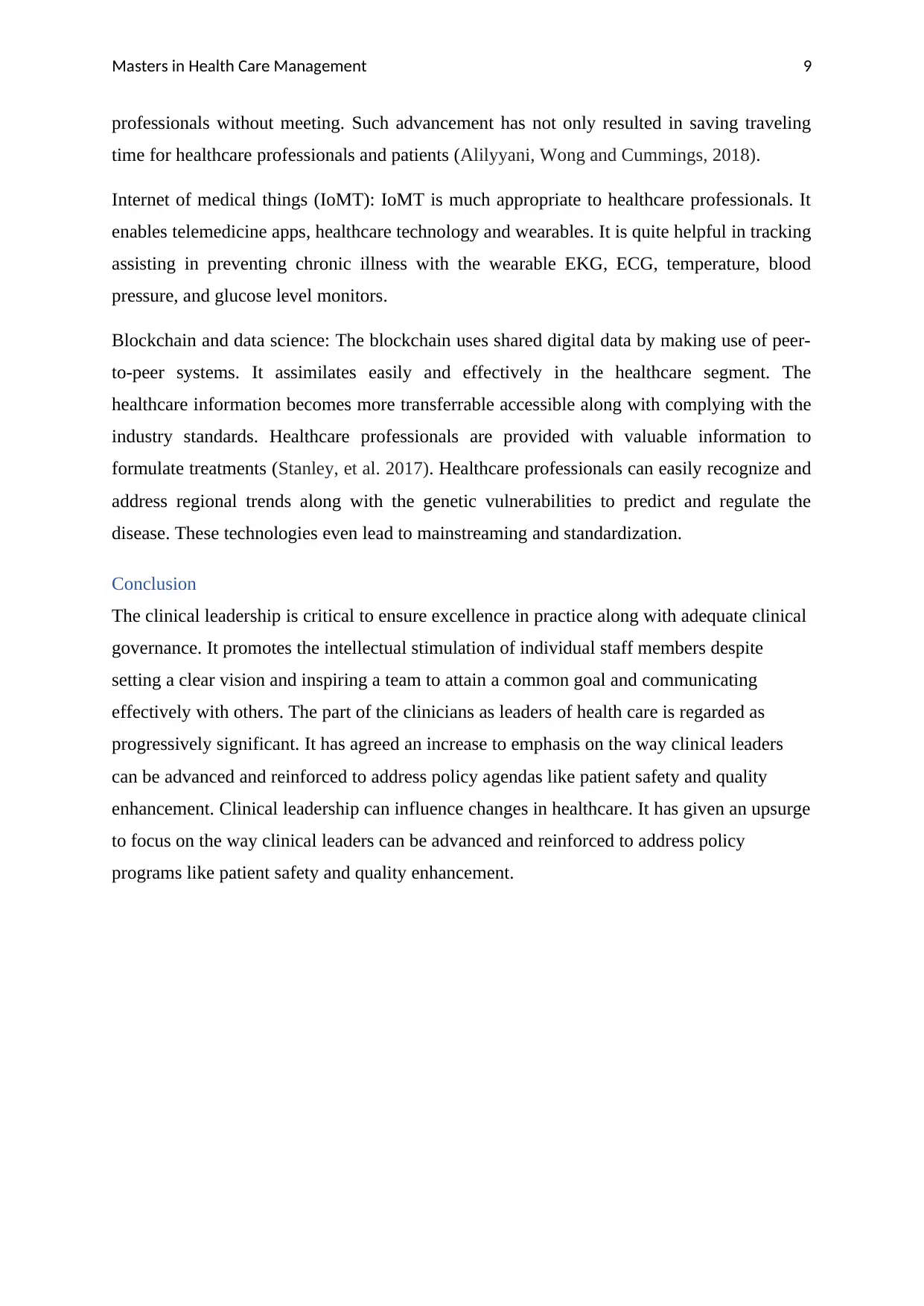
Masters in Health Care Management 9
professionals without meeting. Such advancement has not only resulted in saving traveling
time for healthcare professionals and patients (Alilyyani, Wong and Cummings, 2018).
Internet of medical things (IoMT): IoMT is much appropriate to healthcare professionals. It
enables telemedicine apps, healthcare technology and wearables. It is quite helpful in tracking
assisting in preventing chronic illness with the wearable EKG, ECG, temperature, blood
pressure, and glucose level monitors.
Blockchain and data science: The blockchain uses shared digital data by making use of peer-
to-peer systems. It assimilates easily and effectively in the healthcare segment. The
healthcare information becomes more transferrable accessible along with complying with the
industry standards. Healthcare professionals are provided with valuable information to
formulate treatments (Stanley, et al. 2017). Healthcare professionals can easily recognize and
address regional trends along with the genetic vulnerabilities to predict and regulate the
disease. These technologies even lead to mainstreaming and standardization.
Conclusion
The clinical leadership is critical to ensure excellence in practice along with adequate clinical
governance. It promotes the intellectual stimulation of individual staff members despite
setting a clear vision and inspiring a team to attain a common goal and communicating
effectively with others. The part of the clinicians as leaders of health care is regarded as
progressively significant. It has agreed an increase to emphasis on the way clinical leaders
can be advanced and reinforced to address policy agendas like patient safety and quality
enhancement. Clinical leadership can influence changes in healthcare. It has given an upsurge
to focus on the way clinical leaders can be advanced and reinforced to address policy
programs like patient safety and quality enhancement.
professionals without meeting. Such advancement has not only resulted in saving traveling
time for healthcare professionals and patients (Alilyyani, Wong and Cummings, 2018).
Internet of medical things (IoMT): IoMT is much appropriate to healthcare professionals. It
enables telemedicine apps, healthcare technology and wearables. It is quite helpful in tracking
assisting in preventing chronic illness with the wearable EKG, ECG, temperature, blood
pressure, and glucose level monitors.
Blockchain and data science: The blockchain uses shared digital data by making use of peer-
to-peer systems. It assimilates easily and effectively in the healthcare segment. The
healthcare information becomes more transferrable accessible along with complying with the
industry standards. Healthcare professionals are provided with valuable information to
formulate treatments (Stanley, et al. 2017). Healthcare professionals can easily recognize and
address regional trends along with the genetic vulnerabilities to predict and regulate the
disease. These technologies even lead to mainstreaming and standardization.
Conclusion
The clinical leadership is critical to ensure excellence in practice along with adequate clinical
governance. It promotes the intellectual stimulation of individual staff members despite
setting a clear vision and inspiring a team to attain a common goal and communicating
effectively with others. The part of the clinicians as leaders of health care is regarded as
progressively significant. It has agreed an increase to emphasis on the way clinical leaders
can be advanced and reinforced to address policy agendas like patient safety and quality
enhancement. Clinical leadership can influence changes in healthcare. It has given an upsurge
to focus on the way clinical leaders can be advanced and reinforced to address policy
programs like patient safety and quality enhancement.
Paraphrase This Document
Need a fresh take? Get an instant paraphrase of this document with our AI Paraphraser
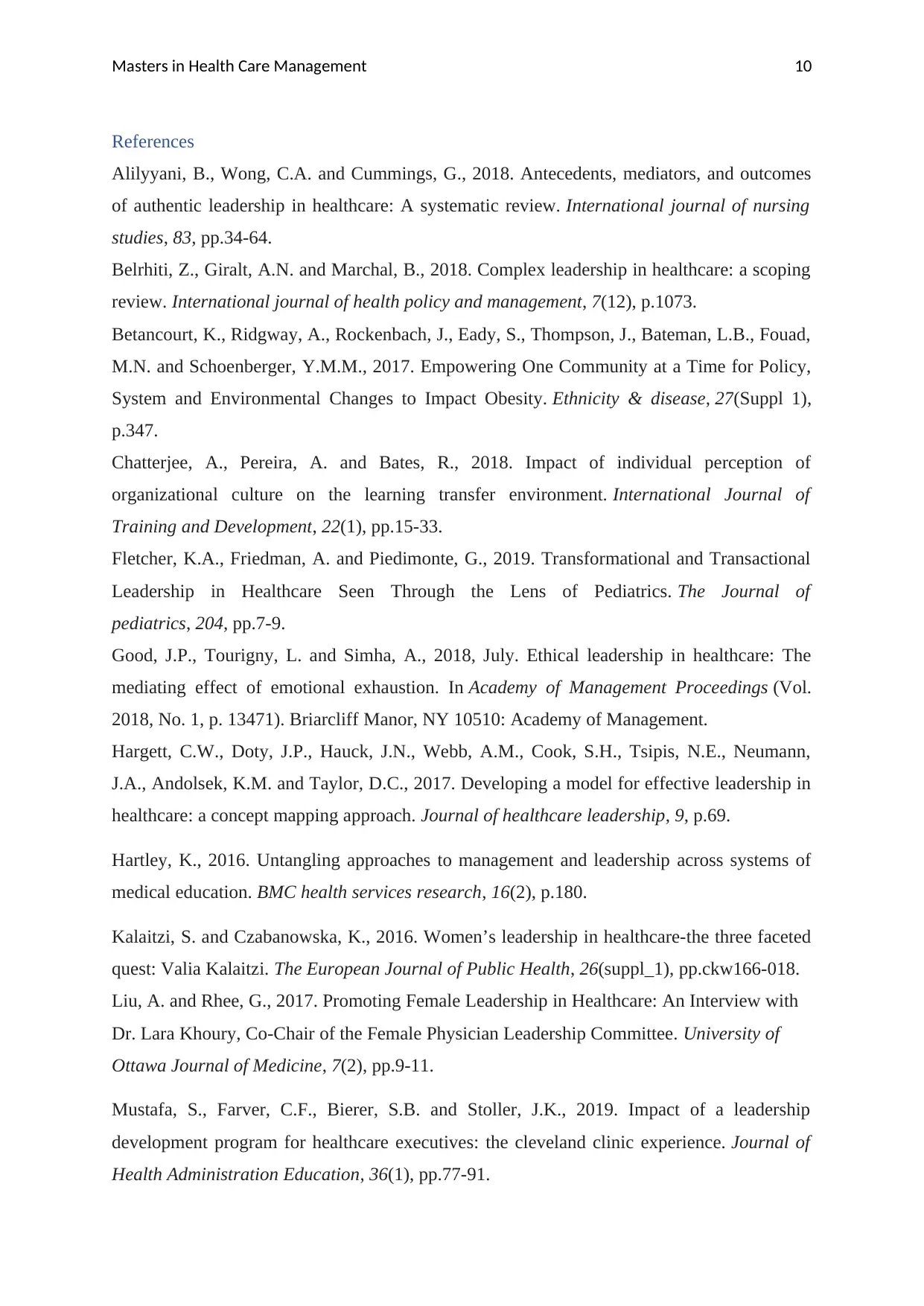
Masters in Health Care Management 10
References
Alilyyani, B., Wong, C.A. and Cummings, G., 2018. Antecedents, mediators, and outcomes
of authentic leadership in healthcare: A systematic review. International journal of nursing
studies, 83, pp.34-64.
Belrhiti, Z., Giralt, A.N. and Marchal, B., 2018. Complex leadership in healthcare: a scoping
review. International journal of health policy and management, 7(12), p.1073.
Betancourt, K., Ridgway, A., Rockenbach, J., Eady, S., Thompson, J., Bateman, L.B., Fouad,
M.N. and Schoenberger, Y.M.M., 2017. Empowering One Community at a Time for Policy,
System and Environmental Changes to Impact Obesity. Ethnicity & disease, 27(Suppl 1),
p.347.
Chatterjee, A., Pereira, A. and Bates, R., 2018. Impact of individual perception of
organizational culture on the learning transfer environment. International Journal of
Training and Development, 22(1), pp.15-33.
Fletcher, K.A., Friedman, A. and Piedimonte, G., 2019. Transformational and Transactional
Leadership in Healthcare Seen Through the Lens of Pediatrics. The Journal of
pediatrics, 204, pp.7-9.
Good, J.P., Tourigny, L. and Simha, A., 2018, July. Ethical leadership in healthcare: The
mediating effect of emotional exhaustion. In Academy of Management Proceedings (Vol.
2018, No. 1, p. 13471). Briarcliff Manor, NY 10510: Academy of Management.
Hargett, C.W., Doty, J.P., Hauck, J.N., Webb, A.M., Cook, S.H., Tsipis, N.E., Neumann,
J.A., Andolsek, K.M. and Taylor, D.C., 2017. Developing a model for effective leadership in
healthcare: a concept mapping approach. Journal of healthcare leadership, 9, p.69.
Hartley, K., 2016. Untangling approaches to management and leadership across systems of
medical education. BMC health services research, 16(2), p.180.
Kalaitzi, S. and Czabanowska, K., 2016. Women’s leadership in healthcare-the three faceted
quest: Valia Kalaitzi. The European Journal of Public Health, 26(suppl_1), pp.ckw166-018.
Liu, A. and Rhee, G., 2017. Promoting Female Leadership in Healthcare: An Interview with
Dr. Lara Khoury, Co-Chair of the Female Physician Leadership Committee. University of
Ottawa Journal of Medicine, 7(2), pp.9-11.
Mustafa, S., Farver, C.F., Bierer, S.B. and Stoller, J.K., 2019. Impact of a leadership
development program for healthcare executives: the cleveland clinic experience. Journal of
Health Administration Education, 36(1), pp.77-91.
References
Alilyyani, B., Wong, C.A. and Cummings, G., 2018. Antecedents, mediators, and outcomes
of authentic leadership in healthcare: A systematic review. International journal of nursing
studies, 83, pp.34-64.
Belrhiti, Z., Giralt, A.N. and Marchal, B., 2018. Complex leadership in healthcare: a scoping
review. International journal of health policy and management, 7(12), p.1073.
Betancourt, K., Ridgway, A., Rockenbach, J., Eady, S., Thompson, J., Bateman, L.B., Fouad,
M.N. and Schoenberger, Y.M.M., 2017. Empowering One Community at a Time for Policy,
System and Environmental Changes to Impact Obesity. Ethnicity & disease, 27(Suppl 1),
p.347.
Chatterjee, A., Pereira, A. and Bates, R., 2018. Impact of individual perception of
organizational culture on the learning transfer environment. International Journal of
Training and Development, 22(1), pp.15-33.
Fletcher, K.A., Friedman, A. and Piedimonte, G., 2019. Transformational and Transactional
Leadership in Healthcare Seen Through the Lens of Pediatrics. The Journal of
pediatrics, 204, pp.7-9.
Good, J.P., Tourigny, L. and Simha, A., 2018, July. Ethical leadership in healthcare: The
mediating effect of emotional exhaustion. In Academy of Management Proceedings (Vol.
2018, No. 1, p. 13471). Briarcliff Manor, NY 10510: Academy of Management.
Hargett, C.W., Doty, J.P., Hauck, J.N., Webb, A.M., Cook, S.H., Tsipis, N.E., Neumann,
J.A., Andolsek, K.M. and Taylor, D.C., 2017. Developing a model for effective leadership in
healthcare: a concept mapping approach. Journal of healthcare leadership, 9, p.69.
Hartley, K., 2016. Untangling approaches to management and leadership across systems of
medical education. BMC health services research, 16(2), p.180.
Kalaitzi, S. and Czabanowska, K., 2016. Women’s leadership in healthcare-the three faceted
quest: Valia Kalaitzi. The European Journal of Public Health, 26(suppl_1), pp.ckw166-018.
Liu, A. and Rhee, G., 2017. Promoting Female Leadership in Healthcare: An Interview with
Dr. Lara Khoury, Co-Chair of the Female Physician Leadership Committee. University of
Ottawa Journal of Medicine, 7(2), pp.9-11.
Mustafa, S., Farver, C.F., Bierer, S.B. and Stoller, J.K., 2019. Impact of a leadership
development program for healthcare executives: the cleveland clinic experience. Journal of
Health Administration Education, 36(1), pp.77-91.
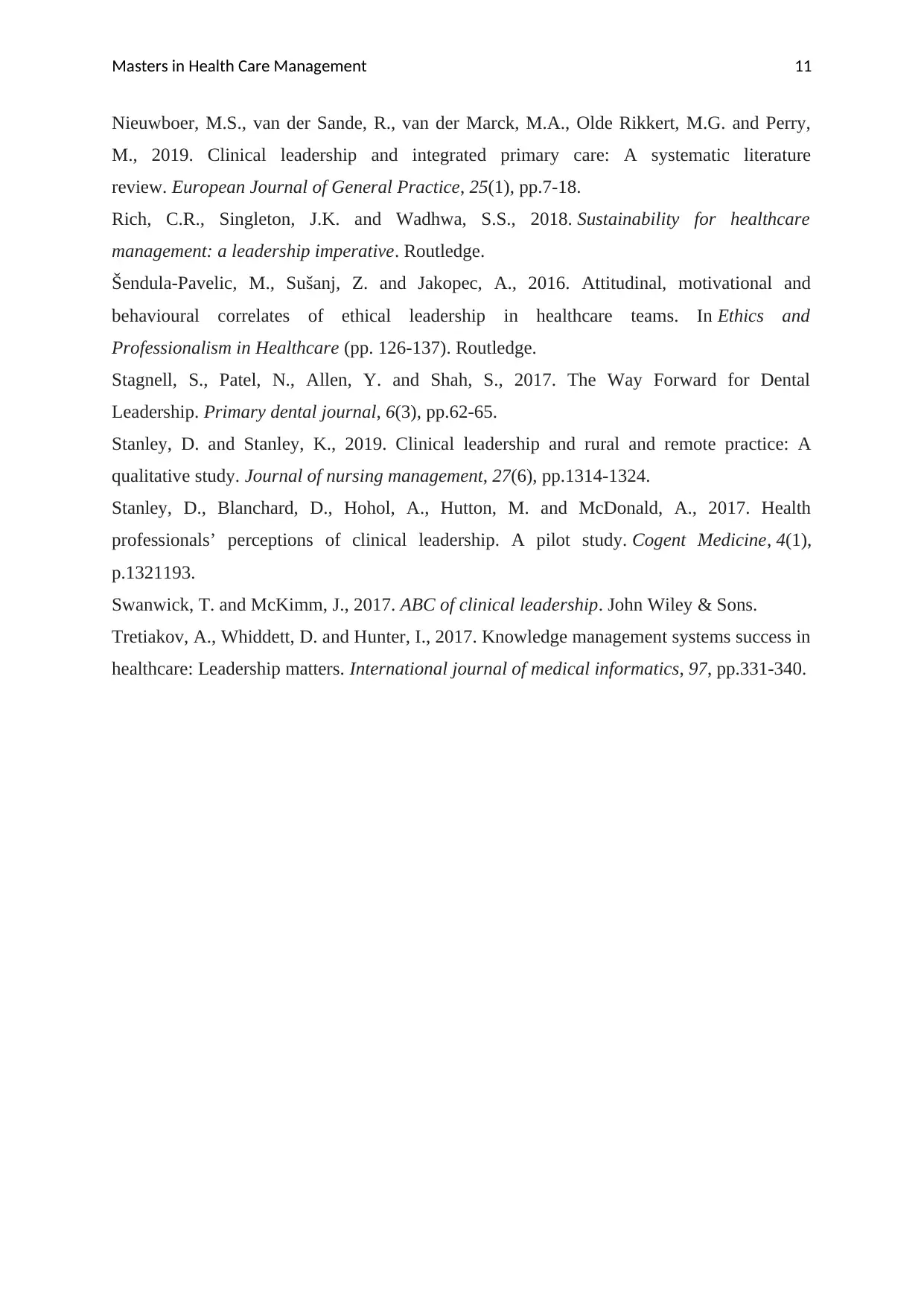
Masters in Health Care Management 11
Nieuwboer, M.S., van der Sande, R., van der Marck, M.A., Olde Rikkert, M.G. and Perry,
M., 2019. Clinical leadership and integrated primary care: A systematic literature
review. European Journal of General Practice, 25(1), pp.7-18.
Rich, C.R., Singleton, J.K. and Wadhwa, S.S., 2018. Sustainability for healthcare
management: a leadership imperative. Routledge.
Šendula-Pavelic, M., Sušanj, Z. and Jakopec, A., 2016. Attitudinal, motivational and
behavioural correlates of ethical leadership in healthcare teams. In Ethics and
Professionalism in Healthcare (pp. 126-137). Routledge.
Stagnell, S., Patel, N., Allen, Y. and Shah, S., 2017. The Way Forward for Dental
Leadership. Primary dental journal, 6(3), pp.62-65.
Stanley, D. and Stanley, K., 2019. Clinical leadership and rural and remote practice: A
qualitative study. Journal of nursing management, 27(6), pp.1314-1324.
Stanley, D., Blanchard, D., Hohol, A., Hutton, M. and McDonald, A., 2017. Health
professionals’ perceptions of clinical leadership. A pilot study. Cogent Medicine, 4(1),
p.1321193.
Swanwick, T. and McKimm, J., 2017. ABC of clinical leadership. John Wiley & Sons.
Tretiakov, A., Whiddett, D. and Hunter, I., 2017. Knowledge management systems success in
healthcare: Leadership matters. International journal of medical informatics, 97, pp.331-340.
Nieuwboer, M.S., van der Sande, R., van der Marck, M.A., Olde Rikkert, M.G. and Perry,
M., 2019. Clinical leadership and integrated primary care: A systematic literature
review. European Journal of General Practice, 25(1), pp.7-18.
Rich, C.R., Singleton, J.K. and Wadhwa, S.S., 2018. Sustainability for healthcare
management: a leadership imperative. Routledge.
Šendula-Pavelic, M., Sušanj, Z. and Jakopec, A., 2016. Attitudinal, motivational and
behavioural correlates of ethical leadership in healthcare teams. In Ethics and
Professionalism in Healthcare (pp. 126-137). Routledge.
Stagnell, S., Patel, N., Allen, Y. and Shah, S., 2017. The Way Forward for Dental
Leadership. Primary dental journal, 6(3), pp.62-65.
Stanley, D. and Stanley, K., 2019. Clinical leadership and rural and remote practice: A
qualitative study. Journal of nursing management, 27(6), pp.1314-1324.
Stanley, D., Blanchard, D., Hohol, A., Hutton, M. and McDonald, A., 2017. Health
professionals’ perceptions of clinical leadership. A pilot study. Cogent Medicine, 4(1),
p.1321193.
Swanwick, T. and McKimm, J., 2017. ABC of clinical leadership. John Wiley & Sons.
Tretiakov, A., Whiddett, D. and Hunter, I., 2017. Knowledge management systems success in
healthcare: Leadership matters. International journal of medical informatics, 97, pp.331-340.
⊘ This is a preview!⊘
Do you want full access?
Subscribe today to unlock all pages.

Trusted by 1+ million students worldwide
1 out of 12
Related Documents
Your All-in-One AI-Powered Toolkit for Academic Success.
+13062052269
info@desklib.com
Available 24*7 on WhatsApp / Email
![[object Object]](/_next/static/media/star-bottom.7253800d.svg)
Unlock your academic potential
Copyright © 2020–2025 A2Z Services. All Rights Reserved. Developed and managed by ZUCOL.





